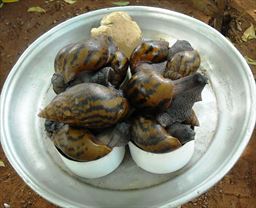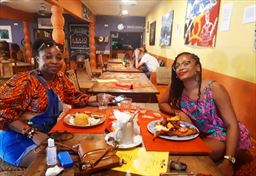Food and Drink of Ghana
Eat and Drink
- General observations
- Easy things to try
- Ghanaian meals
- Where to eat and drink
- Water and other beverages
- Fresh fruits and vegetables
- Meat, fish and dairy
- Snacks and sweets
- Pizza, spaghetti and beef burgers
General observations
The cost of eating in Ghana will differ greatly depending upon whether you eat local Ghanaian food. Eating Chinese, Continental, Lebanese or other non-Ghanaian styles will be rather expensive, probably starting at around $7.00 per dish. Ghanaian meals will be half that, unless served at a restaurant catering to tourists.
It is essential that casual visitors to Ghana take proper precautions when eating. Keep your hands clean and try to ensure your food is prepared and stored in sanitary conditions.
Foods tend to be fried, boiled or grilled. The one common ingredient is a hot pepper that is found in almost everything and makes Ghana food spicy-hot.
Easy things to try
Here are some easy foods for you to try. Not too hot, not too spicy and not to strange to your palate.
- Chichinga
Beef or sausage kabobs. These are prepared by street side vendors. - Kelewele
Fried plantain with ginger and peanuts. Again, prepared by street vendors. - Red Red
Fried plantain with beans and red palm oil. Can be served with or without fish. - Fried Rice
Standard fried rice you would eat anywhere in the world. Plain or with salad, egg and/or chicken. - Jollof Rice
This is a favorite rice dish in Ghana. The rice is prepared with much tomato and less of cooking oil that makes the rice red. As with fried rice, this is served plain or with salad, egg, chicken or beef. - Waakye (pronounced Waa-chi)
This is a mixed bag - literally. Starting with a mix of rice and beans, there may be optional items added. These would include spaghetti, whole boiled eggs and hot pepper. - Fried egg sandwich
There will be places that will fry an egg with some pepper, onion and tomato to make a small omelet that can be eaten in bread.
Ghanaian meals
Ghanaian meals tend to be served in a bowl and are comprised of three parts: A big hunk of a starch placed into the bowl, a soup or stew poured over top of the starch, and large pieces of fish or meat.
Starches
- Fufu
Boiled cassava and plantain pounded into a dough-like mass. - Banku
Ground fermented corn and cassava that is boiled and stirred into a thick starchy mass. - Kenkey
Ground fermented corn that is boiled and pressed into corn husk. - Omo tuo
Plain rice balls - Yam
Like the potato you are familiar with, yams are eaten either boiled or fried. Fried yams are eaten with hot pepper or with a spinach-like Palava sauce rather than with a soup or stew.
Soups and stews
- Groundnut soup
A peanut-based sauce. - Light soup
A tomato and palm nut based soup. - Palm nut soup
A palm nut based soup, more oily than light soup. - Agbamadeshi stew
More difficult to find, this is more likely encountered in Ewe areas. This is a thick and very pleasant stew. - Okra soup or stew
Okra based soup or thicker stew. Requires some special wrist motion to keep from getting it all over yourself.
Meat
- Tilapia is the fish of choice
- Chicken
- Guinea Fowl and Turkey
- Goat
- Beef
Where to eat and drink
- Hotels and Continental Restaurants
- As mentioned, restaurants catering to tourists will be found in all larger towns and cities. This will be the most expensive option.
- Local Restaurants
- When at restaurants, you can expect that half or more of the items on any printed menu will be not available, or "finished" as your server will tell you. Food options in remote areas and villages will be rather limited. Whether in an urban or rural location, portions tend to be large when food is served.
Service in restaurants is generally poor-to-average, unless you are at an expensive restaurant. Poor service can sometimes be avoided by a small tip at the beginning of the relationship with your server. - Chop Bar
- A Chop Bar is a local budget eating establishment. You will find locals eating local food quickly at all times of the day at chop bars located everywhere.
Roadside Vendors or Cold Store
Food is sold everywhere in Ghana.
Water and other beverages
- Water
Drinking water is easy to find anywhere in Ghana. Basically there are two options for drinking water: bottled water and sachet "pure" water.
Bottled water is what you are accustomed to in the West, with Voltic being the big name brand here. Make sure the seal is intact when the bottle is served to you.
Many first time visitors to Ghana are insistent on bottled water. That is fine, but people in Ghana consider that extreme and very expensive. You should feel free to drink pure water without any problem.
Pure water is sold everywhere in small sealed plastic bags. Even though this type of water has gone through a filtration system, there are no standards and each company producing pure water uses a different filtration technique. The water inside is clean, but beware what is on the outside of the sachet. - Other Beverages
All types of other beverages are available, from the ubiquitous Coca-Cola products, to juices, energy drinks, and soy beverages. Getting these served very cold becomes more difficult the farther you are from a city.
Juices may be either fresh, bottled, in a can or in a carton. Pineapple juice, orange juice, mango and guava are the most prevalent fruit juices. Fresh coconut juice is sold anywhere you see a pile of coconuts. Tampico is a refreshing juice drink sold in plastic bottles, while Milo is a chocolate beverage served cold along the roadside or hot for morning breakfast.
Unless at an upscale restaurant, you should avoid ice cubes. You do not know what water has been used to produce them. - Palm Wine, Akpeteshie and Kasapreko
Alcoholic beverages are a big part of life, whether it be for ceremony or the evening shot of akpeteshie (distilled palm wine). The blue and white picket fences you see are used to indicate a drinking establishment, or 'spot' as it is called in Ghana. You will frequently see people pour a small part of their libation on the ground as an offering to their ancestors.
Fresh fruits and vegetables
For fruits, make sure the skin is not broken and be sure to wash well with clean water. Many street vendors will sell fruit that is already cut. You should avoid this and take a fresh fruit that they cut in front of you.
The most commonly encountered fruits are orange, pineapple, mango, papaya, melon, coconut, guava and imported apples. Other fruits can be found in large supermarkets, but you will pay dearly for them.
Vegetables are limited to a few staples. Besides yam, the most common vegetables in the diet are corn, tomato, onion, beans and squash. Leafy vegetables are available also, but great care should be taken in preparing any vegetable that is eaten fresh.
Plantains (fruit or vegetable?) are the main staple of the food supply in Ghana. It looks like a banana, but tastes far different. Only when fried does it become sweet. It is also served fried into chips, grilled, with a side of peanuts, and boiled and mashed into fufu or other starches and noted in a previous section.
Peanuts are called 'groundnuts' in Ghana. (again, fruit or vegetable?) They are easy to find at most shops and anyplace where bananas or grilled plantains are being sold.
Meat, fish and dairy
Milk, cheese and other dairy products are rare in the Ghanaian diet and generally can only be found at large supermarkets or as Fan Milk frozen products (see below). On the other hand, soy milk can be found at any cold store.
Beware of butter and mayonnaise. These are typically not refrigerated and can be bad.
Snacks and sweets
Snacks are everywhere. It is a constant part of life, spending a small amount for a small snack.
Plantain chips are easily found.
Zoe is corn meal mixed with peanut butter, ginger and hot pepper to make small round snacks about the size of a golf ball.
Locally produced chocolate is sold mostly as Kingbite chocolate bars produced by the Cocoa Processing Company, Ghana's only chocolate manufacturer. Unfortunately, the factory does not give tours.
FanMilk dairy products are sold everywhere by street vendors. These include frozen strawberry yogurt, vanilla ice cream and frozen chocolate milk all in individual size packets. Usually referred to as Fan Ice, the vendors on bicycle will usually have meat pies, cakes, spring rolls and other snack foods too.
Cakes & donuts, popcorn are sold by street vendors.
Pizza, spaghetti and beef burgers
You can find a fair variety of food styles in larger cities, but only Ghanaian meals in rural areas. There are a couple American-style fast food chains, like Pizza Inn/Chicken Inn. You will see these around the larger cities and they serve good pizza and sandwiches. Blissfully, there is not a single McDonald's anywhere in Ghana - yet.
When you see other types of non-Ghanaian meals on a menu, it will be expensive and probably less than satisfactory unless you are at an upscale restaurant or a restaurant that exclusively prepares a particular style of food.
Pasta is considered a Chinese dish here. Most commonly seen is spaghetti Bolognaise, which is generally served in the Italian style as you would expect. Other pasta dishes, like stroganoff, will be more like a Chinese meal.
There are many Chinese, Continental and Lebanese restaurants in Accra and Kumasi. French, Italian, Indian and Thai restaurants are fewer and much more expensive.
Join me for Lunch!
Want to taste youself?
Take a Food Tasting Half-day Tour
(Note: There are no paid recommendations on this page. We link businesses on our site because of their unique offerings - not because they provide any incentives to Easy Track Ghana or our staff.)




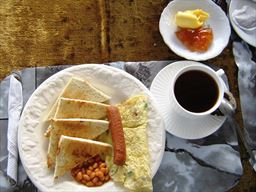
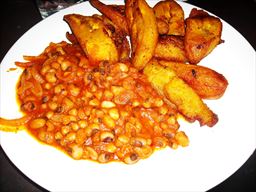
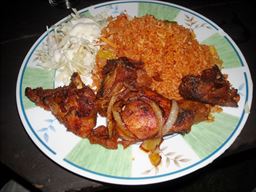
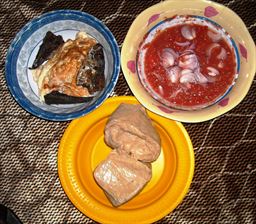
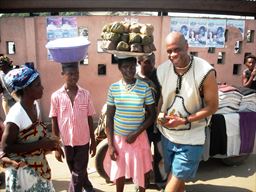
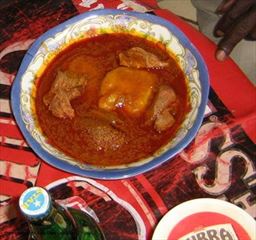
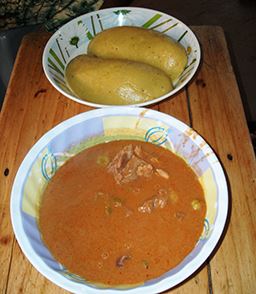
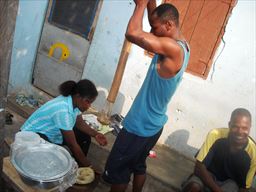
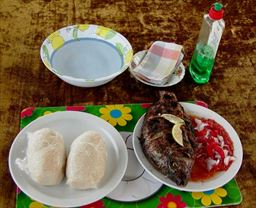
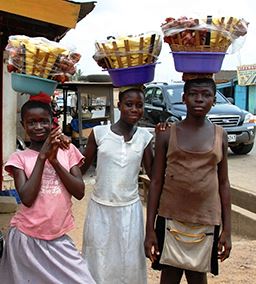
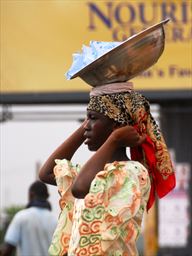
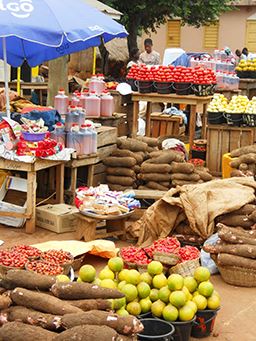
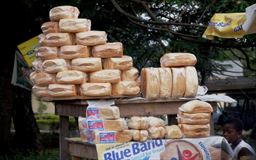

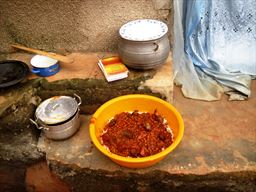
.jpg)
